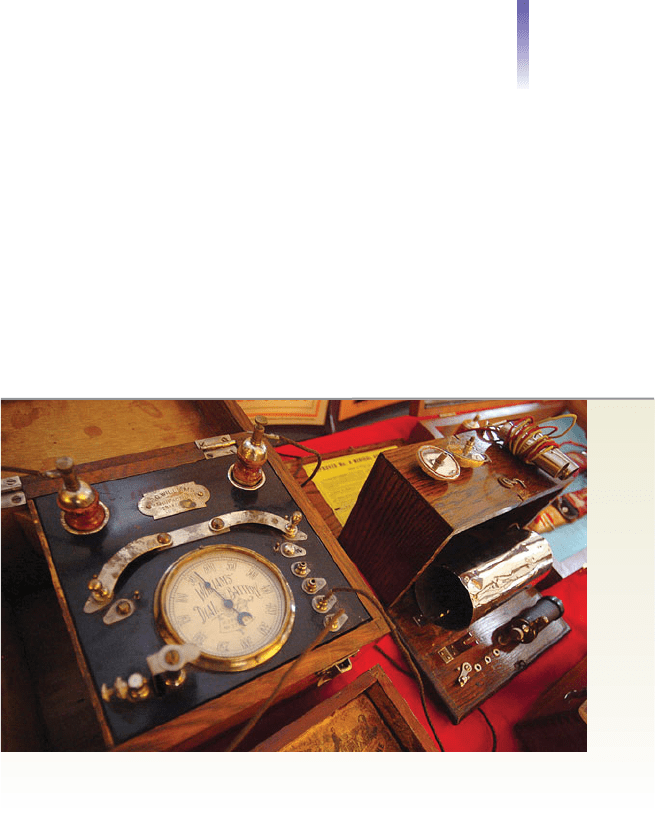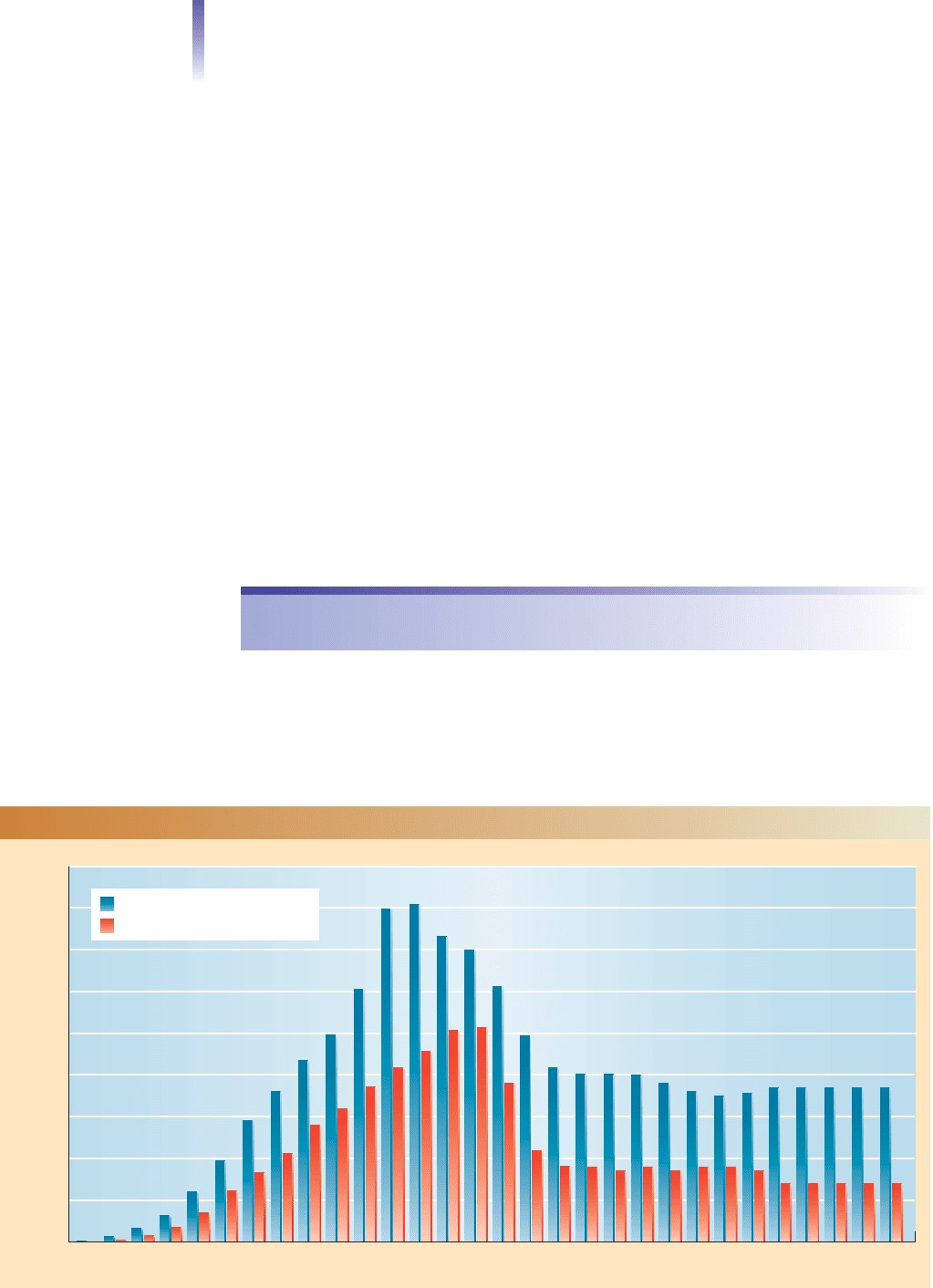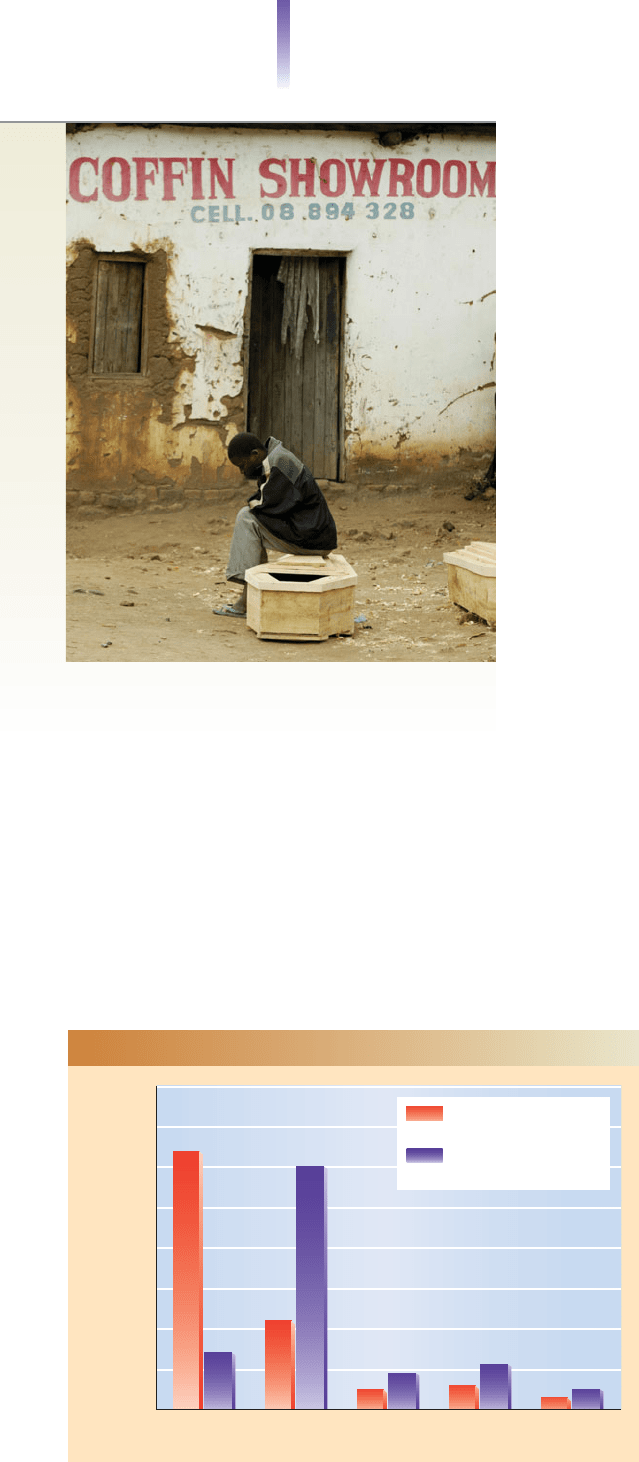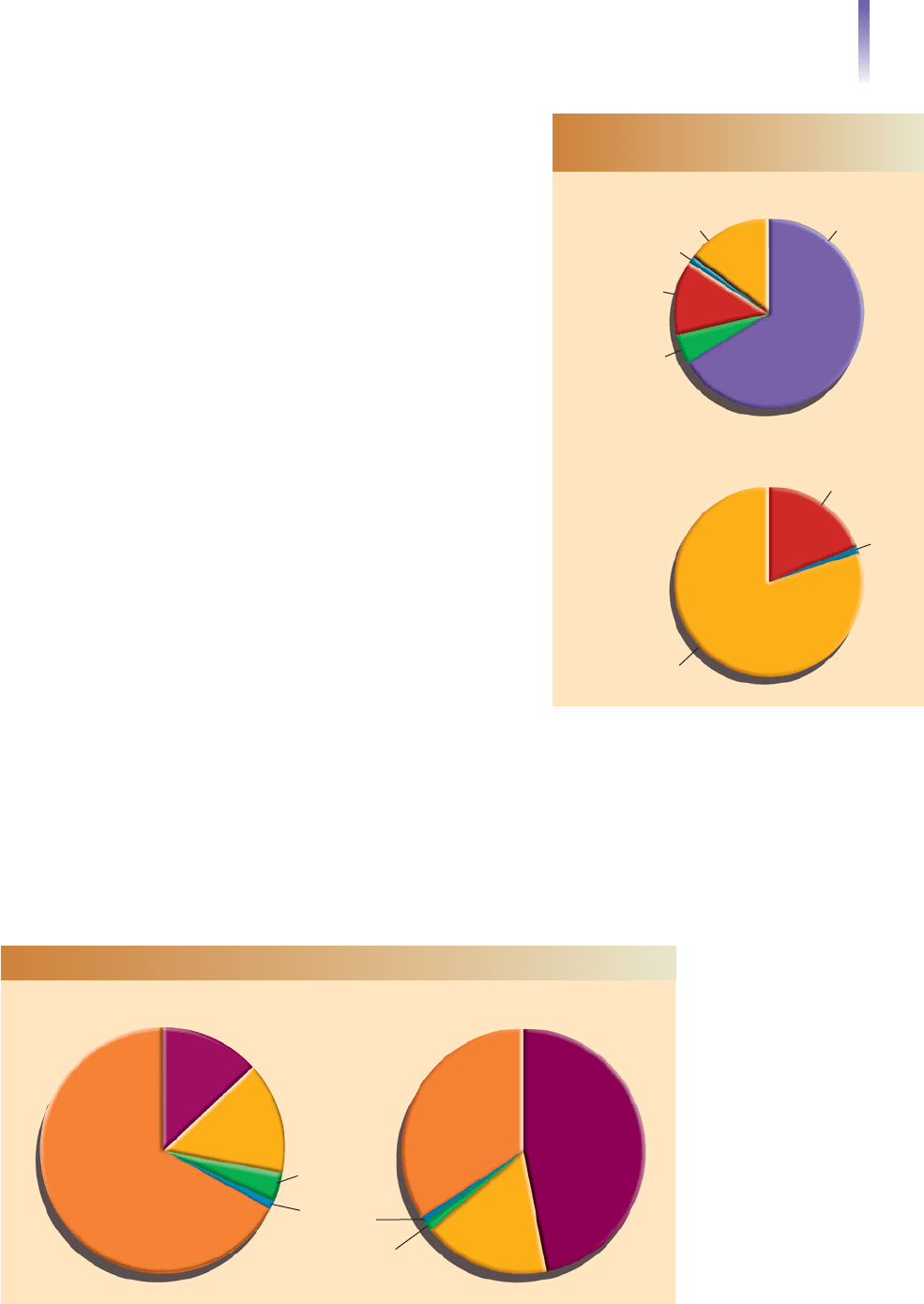Henslin James M. Sociology: A Down to Earth Approach
Подождите немного. Документ загружается.


to increase the sales of the product? Some drug companies even ghostwrite articles for
medical journals that present research about how good their drugs are—and then look for
doctors to list as authors (Ross et al. 2008). With conflict of interest so powerful, new laws
are being passed to curb these practices (Meier 2009).
At Harvard University, the conflict of interest with drug companies has taken an in-
teresting turn. Medical students have protested that when their professors are receiving
money from a pharmaceutical company, what they teach is no longer objective. In re-
sponse to their protest, teachers in the medical school must now inform their students of
all ties they have with drug companies (Wilson 2009).
Medical Fraud
One doctor billed Medicare for treatment of a
patient’s eye—the only problem was that the
patient was missing that eye (Levy 2003). A
dentist charged Medicare for 991 procedures
in a single day. In a typical workday, that
would come to one every 36 seconds (Levy and
Luo 2005). A psychiatrist in California had sex
with his patient—and charged Medicaid for
the time. (Geis et al. 1995)
These are not isolated incidents—they are just
some of the most outrageous. With 3 million
Medicare claims filed every day, physicians are
not likely to be audited (Johnson 2008). Many
doctors have not been able to resist the tempta-
tion to cheat.
Do you recall the section on white collar crime
in Chapter 8, where I pointed out that some
white-collar crime goes far beyond money, that it
harms and kills people? So it is with this white-collar crime. A pharmacist in Kansas City was
so driven by greed that he diluted the drugs he sold for patients in chemotherapy (Belluck
2001). And what do you think Guidant Corporation did when it discovered that its heart de-
fibrillators, which are surgically implanted in patients, could short-circuit and kill patients?
Tell the patients and doctors? You would think so. Instead, the company kept selling the de-
fective model while it developed a new one. Several patients died when their defibrillators
short-circuited (Meier 2005, 2006).
Then there is Bayer, that household name you trust when you reach for aspirin. Bayer
also makes Trasylol, a drug given after heart surgery. Bayer found that its drug had a few
slight side effects—it could increase the risk of strokes, damage kidneys, and cause heart
failure and death. Did Bayer warn doctors that they might be killing their patients? Not
at all. In Bayer’s own words, it “mistakenly did not inform” the Federal Drug Adminis-
tration of the study (Harris 2006). In the same vein that Bayer made its statement, I will
assume that the $200 million annual sales of this drug had nothing to do with Bayer
making this mistake.
Greed can be so enticing that it ensnares even outstanding individuals, distorting their
ethics and sense of reality. A top medical researcher at Harvard who was also the head of
pediatric research at Massachusetts General Hospital told the drug company, Johnson &
Johnson, that if they funded his research, his findings would benefit the company (Harris
2009). No honest researcher knows in advance what research findings will be.
Sexism and Racism in Medicine
In Chapter 11 (pages 310–311), we saw that physicians don’t take women’s health com-
plaints as seriously as they do those of men. As a result, surgeons operate on women after
the women’s heart disease has progressed farther, which makes it more likely that the
women will die from the disease. This sexism is so subtle that the physicians are not even
Issues in Health Care 571
Today’s medical fraud is more sophisticated than this Specto-Chrome of years
past, a machine that could cure anything with colored lights, but the goal is
always the same, money.

aware that they are discriminating against women. Some sexism in medicine, in contrast,
is blatant. One of the best examples is the bias against women’s reproductive organs that
we reviewed in Chapter 11 (page 312).
Racism is also an unfortunate part of medical practice. In Chapter 12, we reviewed
racism in surgery and in health care after heart attacks. You might want to review these
materials on page 339.
The Medicalization of Society
As we have seen, childbirth and women’s reproductive organs have come to be defined as
medical matters. Sociologists use the term medicalization to refer to the process of turn-
ing something that was not previously considered a medical issue into a medical matter.
“Bad” behavior is an example. If a psychiatric model is followed, crime becomes not will-
ful behavior that should be punished, but a symptom of unresolved mental problems that
were created during childhood. These problems need to be treated by doctors. The human
body is a favorite target of medicalization. Characteristics that once were taken for
granted—such as wrinkles, acne, balding, sagging buttocks and chins, bulging stomachs,
and small breasts—have become medical problems, all in need of treatment by physicians.
As usual, the three theoretical perspectives give us contrasting views of the medicalization
of such human conditions. Symbolic interactionists would stress that there is nothing inher-
ently medical about wrinkles, acne, balding, sagging chins, and so on. It is a matter of def-
inition: People used to consider such matters as normal problems of life; now they are
starting to redefine them as medical problems. Functionalists would stress that the medical-
ization of such conditions is functional for the medical establishment. It strengthens the
medical establishment by broadening its customer base. Conflict sociologists would argue
that such medicalization indicates the growing power of the medical establishment: The
more conditions of life that physicians can medicalize, the greater their profits and power.
Medically Assisted Suicide
To consider medically assisted suicide takes us face to face with controversial issues that
are both disturbing and difficult to resolve. Should doctors be able to write lethal prescrip-
tions for terminally ill patients? Some take the position that this will relieve suffering and
help people to die with dignity. Others say that such laws would simply legalize murder.
Let’s explore these issues in the following Thinking Critically section.
572 Chapter 19 MEDICINE AND HEALTH
medicalization the transfor-
mation of a human condition
into a matter to be treated by
physicians
euthanasia mercy killing
Thinking CRITICALLY
Should Doctors Be Allowed to Kill Patients?
Except for the name, this is a true story:
Bill Simpson, in his 70s, had battled leukemia for years. After his spleen was removed, he devel-
oped an abdominal abscess. It took another operation to drain it.A week later, the abscess filled
and required more surgery.Again the abscess returned. Simpson began to go in and out of con-
sciousness. His brother-in-law suggested euthanasia.The surgeon injected a lethal dose of mor-
phine into Simpson’s intravenous feeding tubes.
At a medical conference in which euthanasia, mercy killing, was discussed, a cancer
specialist who had treated thousands of patients announced that he had kept count of the
patients who had asked him to help them die.“There were 127 men and women,” he said.
He paused, and then added,“And I saw to it that 25 of them got their wish.” Thousands of
other physicians have done the same (Nuland 1995).
When a doctor ends a patient’s life, such as by injecting a lethal drug, it is called active eu-
thanasia. To withhold life support (nutrients or liquids) is called passive euthanasia. To re -
move life support, such as disconnecting a patient from oxygen falls somewhere in between.
The result, of course, is the same.

Issues in Health Care 573
Dr. Phillip Nitschke (“Dr. Death”) showing his euthanasia items at a “Killing Me Softly”
conference in Sidney, Australia. The bag he is holding is connected by a hose to a generator and
placed over someone’s head. The individual dies by carbon dioxide poisoning.
Two images seem to dominate the public’s ideas of euthanasia: One is of an individual
devastated by chronic pain. The doctor mercifully helps to end that pain by performing
euthanasia. The second is of a brain-dead individual—a human vegetable—who lies in a
hospital bed, kept alive only by machines. How accurate are these images?
We have the example of Holland. There, along with Belgium, euthanasia is legal. Incredi-
bly, in about 1,000 cases a year, physicians kill their patients without the patients’ express
consent. In one instance a doctor ended the life of a nun because he thought she would
have wanted him to do so but was afraid to ask because it was against her religion. In an-
other case, a physician killed a patient with breast cancer who said that she did not want
euthanasia. In the doctor’s words,“It could have taken another week before she died. I
needed this bed” (Hendin 1997, 2000).
Some Dutch, concerned that they could be euthanized if they have a medical emergency,
carry “passports” that instruct medical personnel that they wish to live. Most Dutch, how-
ever, support euthanasia. Many carry another “passport,” one that instructs medical person-
nel to carry out euthanasia (Shapiro 1997).
In Michigan, Dr. Jack Kevorkian, a pathologist (he didn’t treat patients—he studied dis-
eased tissues) decided that regardless of laws, he had the right to help people commit sui-
cide. He did, 120 times. Here is how he described one of those times:
I started the intravenous dripper, which released a salt solution through a needle into her vein,
and I kept her arm tied down so she wouldn’t jerk it. This was difficult as her veins were fragile.
And then once she decided she was ready to go, she just hit the switch and the device cut off
the saline drip and through the needle released a solution of thiopental that put her to sleep in
ten to fifteen seconds. A minute later, through the needle flowed a lethal solution of potassium
chloride. (Denzin 1992)
Kevorkian taunted authorities. He sometimes left bodies in vans and dropped them off at
hospitals. Although he provided the poison, as well as a “death machine” that he developed
to administer the poison, and he watched patients pull the lever that released the drugs,
Kevorkian never touched that lever. Frustrated Michigan prosecutors tried Kevorkian for
murder four times, but four times juries refused to convict him. Then Kevorkian made a
fatal mistake. On national television, he played a videotape showing him giving a lethal injec-
tion to a man who was dying from Lou Gehrig’s disease. Prosecutors put Kevorkian on trial
again. This time, he was convicted of second-degree murder and was sentenced to 10 to 25
years in prison. Kevorkian was released after 8 years. To get out, he had to promise not to
kill anyone else (Wanzer 2007).

Curbing Costs: From Health Insurance
to Rationing Medical Care
We have seen some of the reasons why the cost of medical care in the United States has
soared: advanced—and expensive—technology for diagnosis and treatment, a growing
elderly population, tests performed as defensive measures rather than for medical reasons,
malpractice insurance, and health care as a commodity to be sold to the highest bidder.
As long as these conditions exist, the price of medical care will continue to outpace infla-
tion. Let’s look at some attempts to reduce costs.
Health Maintenance Organizations. Some medical companies—health maintenance
organizations (HMOs)—charge an annual fee in exchange for providing medical care to
a company’s employees. Prices are lower because HMOs bid against one another. What-
ever money is left over at the end of the year is the HMO’s profit. While this arrangement
eliminates unnecessary medical treatment, it can also reduce necessary treatment. The re-
sults are anything but pretty.
Over her doctor’s strenuous objections, a friend of mine was discharged from the hospi-
tal even though she was still bleeding and running a fever. Her HMO representative said
he would not authorize another day in the hospital. After suffering a heart attack, a man
in Kansas City, Missouri, needed surgery that could be performed only at Barnes Hospi-
tal in St. Louis, Missouri. The HMO said, “Too bad. That hospital is out of our service
area.” The man died while appealing the HMO decision (Spragins 1996). Some doctors
also have HMOs. One doctor, who works for a hospital, noticed a lump in her breast.
She went to the x-ray department to get a mammogram, but her own hospital said she
couldn’t have one. Her HMO allowed one mammogram every two years, and she had had
one 18 months before. After a formal appeal, she was granted an exception. She had breast
cancer. (“What Scares Doctors?” 2006)
The basic question, of course, is: At what human cost do we reduce spending on med-
ical treatment?
Diagnosis-Related Groups. To curb spiraling costs, the federal government has classified all
illnesses into diagnosis-related-groups (DRGs) and has set an amount that it will pay for the
574 Chapter 19 MEDICINE AND HEALTH
The cartoonist has captured
an unfortunate reality of U.S.
medicine.
Only in Oregon (since 1997) and Washington (since 2008) is it legal for doctors to assist
in suicide, and only under strict rules. If Kevorkian had lived in Oregon or Washington, and
he hadn’t begun killing patients until those years, he would never have been convicted.
For Your Consideration
Do you think Oregon and Washington are right? Why? In the future, do you think other
states will approve medically assisted suicide?
In addition to what is reported here, Dutch doctors also kill newborn babies who have
serious birth defects (Smith 1999;“Piden en Holanda . . .” 2004).Their justification is that if
these children live they would not have “quality of life.” Would you support this?

treatment of each illness. Hospitals make a profit if they move patients through the system
quickly—if they discharge patients before the allotted amount is spent. As a consequence,
some patients are discharged before they have recovered. Others are refused admittance be-
cause they appear to have a “worse than average” case of a particular illness: If they take longer
to treat, they will cost the hospital money instead of bringing them a profit.
National Health Insurance
The van from Hollywood Presbyterian Hospital pulled up to the curbside in the center of skid
row in Los Angeles, California. The driver got out and walked to the passenger side. As several
people watched, she opened the door and helped a paraplegic man out. As she drove away, leav-
ing the befuddled man, people shouted at her, “Where’s his wheelchair? Where’s his walker?”
Someone called 911. The police found the man crawling in the gutter, wearing a flimsy,
soiled hospital gown and trailing a broken colostomy bag.
“I can’t think of anything colder than that,” said an L.A. detective. “It’s the worst area of
skid row.” (Blankstein and Winton 2007)
This is a blatant example of dumping, hospitals discharging unprofitable patients. Seldom
is dumping as dramatic as in this instance, but dumping is not unusual. Dumping is one
consequence of a system that puts profit ahead of patient care. With 47 million Ameri-
cans uninsured (Statistical Abstract 2009:Table 147), pressure has grown for the govern-
ment to provide national health insurance. What patterns do you see in the Social Map
below, which shows how the uninsured are distributed among the states?
Advocates of national health insurance point out that centralized, large-scale purchases
of medical and hospital supplies will reduce costs. They also stress that national health in-
surance will solve the problem of the poor receiving inferior medical care. Opponents
stress that national health insurance will bring expensive red tape. They also ask why any-
one would think that federal agencies—such as those that run the post office—should be
entrusted with administering something as vital as the nation’s health care. Proponents
reply that right now no one is in charge of it. This debate is not new, and even if some
form of national health insurance is adopted, the arguments will continue.
Issues in Health Care 575
Less than average: 5.5 to 11.9
Average: 12.1 to 15.6
Higher than average: 15.8 to 25.1
The percentage of a state’s
residents who have no medical insurance
AK
SC
NC
VA
WA
OR
CA
NV
ID
MT
WY
AZ
NM
CO
ND
SD
NE
KS
OK
TX
MN
IA
MO
AR
LA
WI
IL
KY
TN
MS
AL
GA
FL
IN
MI
WV
PA
NY
ME
NH
MA
RI
CT
NJ
DE
MD
DC
HI
VT
UT
OH
FIGURE 19.6 Who Lacks Medical Insurance?
Source: By the author. Based on Statistical Abstract of the United States 2011:Table 152.
dumping the practice of
sending unprofitable patients to
public hospitals
Note: The range is broad, from 8.6 percent who lack medical insurance in Rhode Island to
24.5 percent in Texas.

Maverick Solutions
Single ear infections $40
Simple cuts with suture removal $95
Ingrown toenail corrections $150
The Tennessee doctor who put this billboard up outside his clinic had grown tired of hav-
ing to hire people to fill out and submit insurance claims, and then waiting to get paid,
or having the forms rejected and having to resubmit them (Brown 2007). To avoid these
frustrations and the cost of dealing with insurance companies, this doctor, like a few oth-
ers, opened a pay-as-you-go clinic. No insurance allowed. Payments only by cash or credit
card. With no billing costs, the doctors can charge less.
Other doctors are lowering costs by replacing individual consultations with group care.
They meet with a group of patients who have similar medical conditions. Eight or ten
pregnant women, for example, go in for their obstetrics checkup together. This allows
the doctor more time to discuss medical symptoms and treatments, and, at the same time,
to charge each patient less. The patients also benefit from the support and encourage-
ment of people who are in their same situation (Bower 2003).
Rationing Medical Care. The most controversial suggestion for how to reduce medical
costs is to ration medical care. The argument is simple: We cannot afford to provide all the
available technology to everyone, so we have to ration it. No easy answer has been found for
this dilemma, the focus of the Sociology and the New Technology box on the next page.
Threats to Health
Let’s look at major threats to health, both in the United States and worldwide.
HIV/AIDS
In 1981, the first case of AIDS (acquired immune deficiency syndrome) was documented.
Since then, about 600,000 Americans have died from AIDS. As you can see from Figure 19.7,
576 Chapter 19 MEDICINE AND HEALTH
0
40,000
30,000
20,000
10,000
50,000
60,000
70,000
80,000
90,000
Year
1981
1982
1983
1984
1985
1986
1987
1988
1989
1990
1991
1992
1993
1994
1995
1996
1997
1998
1999
2000
2001
2002
2003
2004
2005
2006
2007*
2009*
2010*
2008*
New cases reported that year
Deaths reported that year
FIGURE 19.7 The Path of AIDS in the United States
Note: Alternative estimates indicate a higher incidence of new cases of HIV (Centers for Disease Control and Prevention 2008c).
*Indicates the author’s projections.
Sources: By the author. Based on Centers for Disease Control and Prevention 2003:Table 21; 2008a:Tables 1, 7.

Threats to Health 577
SOCIOLOGY and the
NEW TECHNOLOGY
Who Should Live, and Who Should
Die? The Dilemma of Rationing
Medical Care
A 75-year old woman enters the emergency
room, screaming and in tears from severe pain.
She is suffering from metastatic cancer (cancer that
has spread through her body). She has only weeks to
live, and she needs immediate admittance to the
intensive care unit.
At this same time, a 20-year old woman, severely
injured in a car wreck, is wheeled into the emer-
gency room.To survive, she must be admitted to the
intensive care unit.
As you probably guessed, there is only one unoccu-
pied bed left in intensive care.What do the doctors do?
This story, not as far-fetched as you might think, distills a
pressing situation that faces U.S. medical health care.
Even though a particular treatment is essential to care
for a medical problem, there isn’t enough of it to go
around to everyone who needs it. Other treatments are
so costly that they could bankrupt society if they were
made available to everyone who had a particular med-
ical problem.Who, then, should receive the benefits of
our new medical technology?
In the situation above, medical care would be ra-
tioned. The young woman would be admitted to inten-
sive care, and the elderly person would be directed
into some ward in the hospital. But what if the elderly
woman had already been admitted to intensive care?
Would physicians pull her out? That is not as easily
done, but probably.
Consider the much less dramatic, more routine
case of dialysis, the use of machines to cleanse the
blood of people who are suffering from kidney disease.
Dialysis is currently available to anyone who needs it,
and the cost runs several billion dollars a year. Many
wonder how the nation can afford to continue to pay
this medical bill. Physicians in Great Britain act much
like doctors would in our opening example. They ra-
tion dialysis informally, making bedside assessments of
patients’ chances of survival and excluding most older
patients from this treatment (Aaron et al. 2005).
Modern medical technology is marvelous. People walk
around with the hearts, kidneys, livers, lungs, and faces of
deceased people. Eventually, perhaps, surgeons will be
able to transplant brains. The costs are similarly astound-
ing. Look again at Figure 19.4 on page 566. Our national
medical bill runs more than $2 trillion a year (Statistical
Abstract 2011:Table 130). Frankly, I can’t understand what
a trillion of anything is. I’ve tried, but the number is just
too high for me to grasp. Now there are two of these
trillions to pay each year.Where can we get such fantastic
amounts? How long can we continue to pay them? These
questions haunt our medical system, making the question
of medical rationing urgent.
The nation’s medical bill will not flatten out. Rather,
it is destined to increase. Medical technology, including
new drugs, continues to advance—and to be costly.
And we all want the latest, most advanced treatment.
Then there is the matter we covered in Chapter 13,
that people are living longer and the number of elderly
is growing rapidly. It is the elderly who need the most
medical care, especially during their last months of life.
The dilemma is harsh: If we ration medical treat-
ment, many sick people will die. If we don’t, we will in-
debt future generations even further.
For Your Consideration
At the heart of this issue lie questions not only of cost
but also of fairness. If all of us can’t have the latest, best,
and most expensive medical care, then how can we dis-
tribute medical care fairly? Use ideas, concepts, and prin-
ciples from this and other chapters to develop a proposal
for solving this issue. How does this dilemma change if
you view it from the contrasting perspectives of conflict
theory, functionalism, and symbolic interactionism?
If we ration medical care, what factors would be fair
to consider? If age is a factor, for example, should the
younger or the older get preferred treatment? Why? If
you are about 20 years old, your answer is likely to be
a quick,“the younger.” But is the matter really that
simple? What about a 40-year old who has a 5-year old
child, for example? Or a 55-year old nuclear physicist?
Or the U.S. president? (OK, why bring that up? He or
she will never get the same medical treatment as we
get. But, wait, isn’t that the point?)
The high cost of some medical treatments, such as dialysis,
shown here, has led to the issue of rationing medical care.

in the United States this disease has been brought under control. New
cases peaked in 1993, and deaths peaked in 1995. This disease is far
from conquered, however. Each year about 35,000 Americans are in-
fected with the HIV virus, and about 14,000 die from it. For the
500,000 Americans who receive treatment, HIV/AIDS has become a
chronic disease that they live with (Centers for Disease Control
2008a:Table 8).
Globally, in contrast, the epidemic is exploding, with 2.7 mil-
lion new HIV infections a year (UNAIDS 2008). Every minute of
every hour of every day, about 5 people become infected with HIV.
Over 40 million people have died from AIDS, but the worst is yet
to come. The most devastated area is sub-Saharan Africa. Although
this region has just 10 percent of the world’s population, it ac-
counts for 67 percent of all people living with HIV and 72 percent
of the world’s deaths from AIDS. The death toll in this region is so
high that the average person dies at age 50. The lowest life ex-
pectancy in the world is in Swaziland. There, the average person is
dead by age 33 (Haub and Kent 2008). As Figure 19.8 illustrates,
Africa is the hardest-hit region of the world.
Let’s look at some of the major characteristics of this disease.
Origin. The question of how HIV/AIDS originated baffled sci-
entists for two decades, but they finally traced its genetic sequences
back to the Congo (Kolata 2001). Apparently, the virus was pres-
ent in chimpanzees and was somehow transmitted to humans.
How this crossover occurred is not known, but the best guess is
that hunters were exposed to the animals’ blood as they slaugh-
tered them for meat.
The Transmission of HIV/AIDS. The only way a person can become infected with the
HIV virus is if bodily fluids pass from one person to another. HIV is most commonly
transmitted through blood, semen, and vaginal secretions, but nursing babies can also get
HIV through the milk of their infected mothers. Since the HIV virus is present in all bod-
ily fluids (including sweat, tears, spittle, and urine), some people think that HIV can also
be transmitted in these forms. The U.S. Centers for Disease Control, however, stresses that
HIV cannot be transmitted by casual contact in which traces of these fluids would be ex-
changed. Figure 19.9 on the next page compares how U.S. men and women get infected.
Gender, Circumcision, and Race–Ethnicity.
In the United States, AIDS hits men the hard-
est, but the proportion of women has been
growing. In 1982, only 6 percent of AIDS cases
were women, but today it is 26 percent (Centers
for Disease Control 1997; 2008b). In sub-
Saharan Africa, AIDS is more common among
women (UNAIDS 2008). Researchers have
found that circumcision reduces a man’s chance
of getting infected with HIV by about half (Mc-
Neil 2006). Because circumcision is not widely
practiced in sub-Saharan Africa, to help stem
the epidemic Israel is sending in circumcision
teams (Kraft 2008).
HIV/AIDS is also related to race–ethnicity.
One of the most startling examples is this:
African American women are 19 times more
likely to come down with AIDS than are white
women (Centers for Disease Control 2008b).
Figure 19.10 on the next page summarizes
578 Chapter 19 MEDICINE AND HEALTH
Africa
64%
14%
22%
5%
9%
60%
11%
3%
5%
6%
Asia Central and
South America
Europe North
America
Percentage
70%
60%
50%
40%
30%
20%
10%
0
80
%
Percent of the worlds
AIDS cases
Percent of the world’s
population
FIGURE 19.8 AIDS: A Global Glimpse
Source: By the author. Based on UNAIDS 2006; Haub and Kent 2008.
With AIDS devastating Malawi and other areas of Africa,
“coffin shops” have become a common sight.This one is in
Blantyre, Malawi.

racial–ethnic differences in this disease. The reason for the differences
shown on this figure is not genetic. No racial–ethnic group is more sus-
ceptible to AIDS because of biological factors. Rather, risks differ be-
cause of social factors, such as the use of condoms and the number of
drug users who share needles.
The Stigma of AIDS. Recall how I stressed at the beginning of this
chapter how social factors are essential to understanding health and ill-
ness. The stigma associated with AIDS is a remarkable example. Some
people refuse even to be tested because they fear the stigma they would
bear if they test HIV-positive. One unfortunate consequence is the con-
tinuing spread of AIDS by people who “don’t want to know.” Even some
governments have put their heads in the sand. Chinese officials, for ex-
ample, at first refused to admit that they had an AIDS problem, but
now they are more open about it. If this disease is to be brought under
control, its stigma must be overcome: AIDS must be viewed like any
other lethal disease—as the work of a destructive biological organism.
Is There a Cure for AIDS? As you saw on Figure 19.7 (page 576),
the number of AIDS cases in the United States increased dramatically,
reached a peak, and then declined. With such a remarkable decline,
have we found a cure for AIDS?
With thousands of scientists doing research, the media have her-
alded each new breakthrough as a possible cure. The most promising
treatment, the one that lies behind the drop in deaths shown in Fig-
ure 19.7, was spearheaded by David Ho, a virologist (virus re-
searcher). If patients in the early stages of the disease take a “cocktail”
of drugs (a combination of protease, fusion, and integrase inhibitors),
their immune systems rebound. Antiretroviral therapy, as it is called,
is not a cure, however. The virus remains, ready to flourish if the
drugs are withdrawn.
While most praise this new treatment, some researchers warn that
the cocktail could become this decade’s penicillin. When penicillin was
introduced, everyone was ecstatic about its effectiveness. However, over the years, the
microbes that penicillin targets mutated, producing “super germs” against which we have
Threats to Health 579
Females
80%
19%
Drug injection
Other
1%
Heterosexual sex
Males
67%
5%
12%
16%
Heterosexual sex
Other 1%
Homosexual
sex
Homosexual
sex and
drug injection
Drug injection
FIGURE 19.9 How Americans
Get AIDS
Source: Centers for Disease Control and Prevention
2008b.
Percentage of AIDS cases
Percentage of U.S. population
African
Americans
47%
Latinos
17%
Whites
34%
Whites
67%
African
Americans
13%
Latinos
15%
4%
Asian
Americans
Native
Americans
1%
Asian
Americans 1%
FIGURE 19.10 People Living with HIV/AIDS by Race–Ethnicity
Source: By the author. Based on Figure 12.5 of this text and Centers for Disease Control and
Prevention 2008b.
Note: “Other” includes unknown and blood
transfusion.
Note: To total 100 percent for the U.S. population and distribute the “claim two or more
race–ethnicities,” I rounded the totals for whites and African Americans up.

little protection. If this happens with AIDS, a tsunami of a “super-AIDS” virus could hit
the world with more fury than the first devastating wave.
Despite their frustrations, medical researchers remain hopeful that they will develop an
effective vaccine. If so, many millions of lives will be saved. If not, this disease will con-
tinue its global death march.
Weight: Too Much and Too Little
When a friend from Spain visited, I asked him to comment on the things that struck him
as different. He mentioned how surprised he was to see people living in metal houses. It
took me a moment to figure out what he meant, but then I understood: He had never seen
a mobile home. Then he added, “And there are so many fat Americans.”
Is this a valid perception, or just some twisted ethnocentric observation by a foreigner? The
statistics bear out his observation. Americans have added weight—and a lot of it. In 1980,
one of four Americans was overweight. By 1990, this percentage had jumped to one of
three. Now about two-thirds (67 percent) of Americans are overweight (Statistical Abstract
1998:Table 242; 2011:Table 207). We have become the fattest nation on earth.
Perhaps we should just shrug our shoulders and say, “So what?” Is obesity really anything
more than someone’s arbitrary idea of how much we should weigh? It turns out that obe-
sity has significant costs. The first is quite unexpected: Obese high school girls are less likely
to go to college (but there is no difference for overweight boys) (Crosnoe 2007). The sec-
ond is health: Obese people are more likely to come down with diabetes, kidney disease,
and some types of cancer (Centers for Disease Control and Prevention 2009a). Obesity’s
health toll is high, accounting for about 112,000 deaths a year (Flegal et al. 2007).
A surprising side-effect of being overweight is that it helps some people live longer.
Evidently, being either seriously overweight (obese) or underweight increases people’s
chances of dying, but being a little overweight is good. No one yet knows the reason for
this, but some suggest that having a few extra pounds reduces bad cholesterol (Centers for
Disease Control 2005).
Alcohol and Nicotine
Many drugs, both legal and illegal, harm their users. Let’s examine some of the health
consequences of alcohol and nicotine, the two most frequently used legal drugs in the
United States.
Alcohol. Alcohol is the standard recreational drug of Americans. The average adult
American drinks 25 gallons of alcoholic beverages per year—about 22 gallons of beer,
3 gallons of wine, and almost 2 gallons of
whiskey, vodka, or other distilled spirits.
Beer is so popular that Americans drink
more of it than they do tea and fruit juices
combined (Statistical Abstract 2011:Table
211).
As you know, despite laws that ban alco-
hol consumption before the age of 21, un-
derage drinking is common. Table 19.1
shows that two-thirds of all high school stu-
dents drink alcohol during their senior year.
If getting drunk is the abuse of alcohol,
then, without doubt, among high school
students abusing alcohol is popular. As this
table also shows, almost half of all high
school seniors have been drunk during the
past year, with 28 percent getting drunk
during just the past month. From this table,
you can also see what other drugs high
school seniors use.
580 Chapter 19 MEDICINE AND HEALTH
Everyone knows that drinking and driving don’t mix. Here’s what’s left of a Ferrari in
Newport Beach, California.The driver of the other car was arrested for drunk driving
and vehicular manslaughter.
